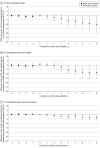Association of State Expansion of Supplemental Nutrition Assistance Program Eligibility With Rates of Child Protective Services-Investigated Reports
- PMID: 36689239
- PMCID: PMC9871943
- DOI: 10.1001/jamapediatrics.2022.5348
Association of State Expansion of Supplemental Nutrition Assistance Program Eligibility With Rates of Child Protective Services-Investigated Reports
Abstract
Importance: States in the US have the option to eliminate the asset test and/or increase the income limit for Supplemental Nutrition Assistance Program (SNAP) eligibility under a policy called broad-based categorical eligibility (BBCE). Given associations of economic hardships, including food insecurity, with child protective services (CPS) involvement, state adoption of these policies may be associated with changes in rates of CPS-investigated reports.
Objective: To examine the association of state elimination of the asset test and increases in the income limit for SNAP eligibility under BBCE with rates of CPS-investigated reports.
Design, setting, and participants: This cross-sectional ecologic study used data from 2006 to 2019 obtained from the SNAP Policy Database and the National Child Abuse and Neglect Data System Child Files and difference-in-differences analyses. The data were analyzed from March to September 2022. The study used CPS-investigated reports for suspected child abuse and neglect from 37 US states to examine elimination of the asset test, from 36 states to examine increases in the income limit, and from 26 states to examine adoption of both policies.
Exposures: State elimination of the asset test, increases in the income limit, and adoption of both policies to expand SNAP eligibility.
Main outcomes and measures: Number of CPS-investigated reports, overall and specifically for neglect and physical abuse, per 1000 child population.
Results: From 2006 to 2019 for all 50 states and the District of Columbia, there were a total of 29 213 245 CPS-investigated reports. By race and ethnicity, 19.8% of CPS-investigated reports were among non-Hispanic Black children and 45.7% among non-Hispanic White children (hereafter referred to as Black and White children). On average, there were 8.2 fewer CPS-investigated reports (95% CI, -12.6 to -4.0) per 1000 child population per year in states that eliminated the asset test, 5.0 fewer CPS-investigated reports (95% CI, -10.8 to 0.7) per 1000 child population per year in states that increased the income limit, and 9.3 fewer CPS-investigated reports (95% CI, -15.6 to -3.1) per 1000 child population per year in states that adopted both SNAP policies than there would have been if these states had not adopted these policies. There were decreases in CPS-investigated reports for neglect in states that adopted either or both policies, and small decreases in CPS-investigated reports for physical abuse in states that increased the income limit or adopted both policies. There were decreases in CPS-investigated reports among both Black and White children. For example, there were 6.5 fewer CPS-investigated reports among Black children (95% CI, -14.6 to 1.6) and 8.7 fewer CPS-investigated reports among White children (95% CI, -15.8 to -1.6) in states that adopted both SNAP policies than there would have been if these states had not adopted these policies.
Conclusions and relevance: Results from this cross-sectional study suggest that state expansion of SNAP eligibility through elimination of the asset test and increases in the income limit may contribute to decreases in rates of CPS-investigated reports. These results can inform ongoing debates regarding SNAP policy options, specifically BBCE, and prevention efforts for child abuse and neglect.
Conflict of interest statement
Figures



Similar articles
-
Public Benefit Programs and Differential Associations With Child Maltreatment by Race and Ethnicity.JAMA Pediatr. 2024 Feb 1;178(2):185-192. doi: 10.1001/jamapediatrics.2023.5521. JAMA Pediatr. 2024. PMID: 38109092 Free PMC article.
-
Surveillance for Violent Deaths - National Violent Death Reporting System, 50 States, the District of Columbia, and Puerto Rico, 2022.MMWR Surveill Summ. 2025 Jun 12;74(5):1-42. doi: 10.15585/mmwr.ss7405a1. MMWR Surveill Summ. 2025. PMID: 40493548 Free PMC article.
-
Changes in Food Insecurity Among US Adults With Low Income During the COVID-19 Pandemic.JAMA Netw Open. 2025 Feb 3;8(2):e2462277. doi: 10.1001/jamanetworkopen.2024.62277. JAMA Netw Open. 2025. PMID: 40019759 Free PMC article.
-
Behavioral interventions to reduce risk for sexual transmission of HIV among men who have sex with men.Cochrane Database Syst Rev. 2008 Jul 16;(3):CD001230. doi: 10.1002/14651858.CD001230.pub2. Cochrane Database Syst Rev. 2008. PMID: 18646068
-
Signs and symptoms to determine if a patient presenting in primary care or hospital outpatient settings has COVID-19.Cochrane Database Syst Rev. 2022 May 20;5(5):CD013665. doi: 10.1002/14651858.CD013665.pub3. Cochrane Database Syst Rev. 2022. PMID: 35593186 Free PMC article.
Cited by
-
Investigating the Poverty-Reducing Effects of SNAP on Non-nutritional Family Outcomes: A Scoping Review.Matern Child Health J. 2024 Mar;28(3):438-469. doi: 10.1007/s10995-024-03898-3. Epub 2024 Feb 19. Matern Child Health J. 2024. PMID: 38372834 Free PMC article.
-
State-Based Eviction Moratoria and Child Maltreatment During the COVID-19 Pandemic.Pediatrics. 2025 May 1;155(5):e2024068174. doi: 10.1542/peds.2024-068174. Pediatrics. 2025. PMID: 40194787
-
Preventing Substance Use and Overdose Among Young Adults: The Role of Social Determinants of Health.Focus (Am Psychiatr Publ). 2024 Oct;22(4):474-482. doi: 10.1176/appi.focus.20240022. Epub 2024 Oct 15. Focus (Am Psychiatr Publ). 2024. PMID: 39563879
-
A Scoping Review to Identify Community- and Societal-Level Strategies Evaluated from 2013 to 2023 for Their Potential Impact on Child Well-Being in the United States.Children (Basel). 2024 Aug 31;11(9):1070. doi: 10.3390/children11091070. Children (Basel). 2024. PMID: 39334603 Free PMC article.
-
Intersection of adverse childhood experiences, suicide and overdose prevention.Inj Prev. 2024 Oct 1;30(5):355-362. doi: 10.1136/ip-2024-045295. Inj Prev. 2024. PMID: 39053926 Review.
References
-
- US Department of Agriculture . Characteristics of SNAP households: FY 2019. March 29, 2021. Accessed August 10, 2022. https://www.fns.usda.gov/snap/characteristics-snap-households-fy-2019

